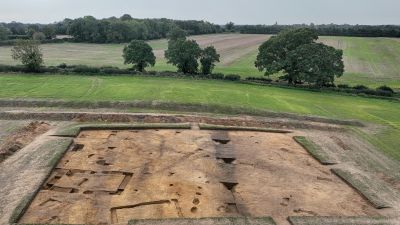Anglo-Saxon Hall of Kings complex near Sutton Hoo is 'size of 20 football pitches'

An Anglo-Saxon complex which contains the remains of a 1,400-year-old royal hall is twice as big as originally thought, say archaeologists.
The compound, near Sutton Hoo at Rendlesham in Suffolk, is about 15 hectares in size - the equivalent of 20 football pitches - and housed the first Kings of East Anglia.
It is part of a wider historical area of 50 hectares - which is said to be a lot larger than other similarly ancient sites.
Discovery of the temple in October last year by a community project run by Suffolk County Council was described as a find of "international significance". Dress, jewellery and personal items which were found all showed that royalty lived at the site.
The location of the royal hall, which is on private farmland, is beingkept a secret to protect the archaeology.
The original dig, which found foundations of three new timber buildings, also showed decorative horse harnesses and fine metalworking.
The East Anglian Kingdom, which made up present day Norfolk and Suffolk, was one of the first Anglo-Saxon kingdoms in Britain and existed for nearly 500 years.
Royal households, like the one discovered at Rendlesham, were used to receive guests from other kingdoms to hold banquets and feasts.
Prof Christopher Scull, who served as the project's principal academic advisor, said the unusually large size of the hall spoke volumes.
He said: "The results of excavations at Rendlesham speak vividly of the power and wealth of the East Anglian kings and the sophistication of the society they ruled.
"The possible temple provides rare and remarkable evidence for the practice at a royal site of the pre-Christian beliefs that underpinned early English society."
Excavation of the royal hall confirmed the writings of the Anglo-Saxon author, The Venerable Bede, who wrote of a royal "temple" which was home to King Raedwald in the seventh century - who was buried four miles away at Sutton Hoo.
The burial grounds at Sutton Hoo date back to the sixth and seventh centuries and archaeologists have been excavating there since 1938 when a ship burial containing Anglo Saxon artefacts was discovered.
The lost treasures from that discovery were recently depicted in the 2021 Netflix film The Dig, which starred Ralph Fiennes, Carey Mulligan and Lily James.
Councillor Melanie Vigo di Gallidoro from Suffolk County Council said the October discovery of the hall was of "international significance".
"This year’s findings round off three seasons of fieldwork which confirm the international significance of Rendlesham’s archaeology and its fundamental importance for our knowledge of early England," she said.
“Everyone involved in the project can take pride that together we have achieved something remarkable.”
Want a quick and expert briefing on the biggest news stories? Listen to our latest podcasts to find out What You Need To Know